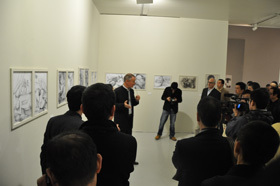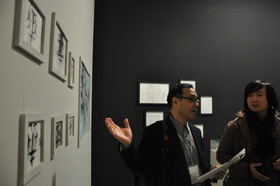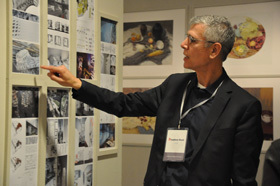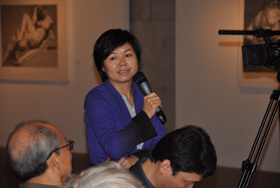
2011年11月30日上午,国际艺术与设计学院院长峰会代表与国内各大美术院校的代表在中央美术学院美术馆2B展厅就“基础教学”问题展开讨论。





中央美术学院院长潘公凯:大家辛苦了。
刚才看了中国和外国的各个美术学院带来的一些关于素描、关于基础教学的作品,这样的一种交流和介绍非常非常有必要,非常非常有意义。尤其是今天在座的有很多中国国内的其他美术学院的基础部负责老师们,他们能够看到世界各地的美术教育代表性学校现在的基础教学和素描教学的情况和成果,而且直接地亲耳听到了诸位校长对这些作品的介绍。虽然因为时间太短,不能够介绍得更详细,但对于我们中国的各个美术学院的基础部教授们来说,是非常非常难得的机会。
中国现在的美术学院的美术教学是在一个世界性的全球化的语境当中进行教学,对于世界各国美术学院的基础教学的了解,尤其是对于在座诸位特别重要的美术学院的基础教学的了解,是我们中国各个美术学院考虑基础教学问题的一个前提性的知识。如果没有一个全球性的背景,如果我们缺乏对国际上的兄弟院校的了解,我们的美术教育就可能会失去方向。所以今天上午我们专门安排了这样一段时间,虽然非常短,大家介绍得也不够充分,我们也没有更多的时间看,但是这个过程还是很必要,因为这给我们中国的美术学院的基础教学带来了一个非常难得的学习机会,诸位外国校长带来的作品大大地打开了我们的眼界,使我们的思维更加开阔,使我们对基础教学的思考更加开阔。
现在我们留下很短的一个多小时的时间,希望国际校长和国内基础教育的老师们有一个互动。老师们昨天已经整整讨论了一天非常具体的教学问题,他们可能有很多想法想问,国内的老师们可以提问,校长们也可以提问,进行相互的讨论。
美国芝加哥美术学院校长Tony Jones:我想代表我的国际同行说几句,代表所有的国际校长。我知道我们作了两天非常深入的讨论,经过潘院长的介绍,也了解到来自八大院校的院长和老师进行了充分的讨论,在昨天的会议上我们已经把我们的会议讨论的议题、达到的共识作了简要的介绍,我想我所有的国际同行非常有兴趣了解诸位中国同行在过去一天的讨论上有什么样的关注、讨论了什么样的内容,非常想了解到你们的关注点和主要得出的结论跟我们是共同的呢,还是有一些和我们不同的对于中国比较独特的问题的关注。
中国美术学院专业基础教学部副主任安滨:我刚才代表中国美术学院基础部向国外校长作了课程的介绍,我是中国美院基础部主任、教授。我今天注意到我们的校长介绍了他们的课程,包括前天我也听了校长论坛中讨论的关于基础教学的看法,昨天我们也在十个学院的范围内探讨了各自的观点。我在中外校长带来的作品中注意到一个共同的特点,就是学生们有相对丰富的表述语言和愿望,在画面中有各自的独特的角度来表现他们的一种绘画语言和思想。实际上在十多年前,1997年我去英国,包括后来我的留学过程中也注意到这个现象,学生们这方面的努力和实践特别多,我也把这个特点带到中国的课程设计中,叫做形式语言,就是对画面和语言的表述。在整体的课程中,我们仍然大比重地对学生进行绘画造型能力的训练,也就是我们今天带来的两大块课程的内容——素描和色彩。从这些作品中,各位校长可能也注意到我们的一种价值和态度。我想问的一个问题是:你们怎么看我们花了这样多的精力在绘画写实能力,包括画面的表达能力和画面的视觉通性以及意境的营造上,花这么大的功夫追求这种画面的质量。
美国加州艺术学院院长Steve Beal:我不知道我是不是能够代表我所有的国际同行来说话,但是首先还是要谢谢潘院长和Tony能够安排这样的机会,让我们能够特别直观地看到学生们的作品,这是非常难得的机会。我个人的观点是,我认为有一种做法是错误的,就是纯粹从观念上、从课程描述上认识这个课程怎么安排、课程的目标是什么,纯粹从观念层面上对一个教学项目、教学课程作出或好或坏的评判。因为当我们最直观地看到这些学生的作品是很重要的,不管课程描述是怎样说的,当你真正看到这些学生的作品,就能感受到它本身所带来的力量,就能为学生所取得的这样的成就而震撼。在我们国家有这样一句老话,“你把自己跟问题拉开得越远,就越容易想出解决的办法”。过去两天时间我们坐在会议室里,围着会议桌讨论了两天,讨论了关于基础教学、关于技能、关于观念、关于课程设置等等话题,当然这个讨论是非常重要和有价值的。但是今天早上的安排无疑是非常非常必要的,当我们环绕着展场看到在各个学校完全不同的多样的教学思想下教出来的不同面貌的学生作品,看到学生最直观的东西,这给我带来的一种感动,经过这样的观看再坐下来讨论,是非常很有益处的。能够在一个场合、一个展览空间里同时看到这样来自不同国家、不同教学思想下、不同的教学课程中培养出来的学生的作品,这种机会是很难得的,所以还是要再一次感谢给我们提供这个机会。
中国美术学院专业基础教学部副主任安滨:我听了这位学校的领导谈了他的看法和对我们的评价,我想表明一个观点,我认为有一个方法论的问题。实际上我们今天要求的高强度的训练是非常必要的,因为有了这个能力,包括其他院校的介绍中画了独特视角的对象,是因为有了这个能力才能画出这个内容,而不是他因为有了某种想法而提高了能力,这个关系要摆清楚。当然我们并不是要死画一个对象,没有任何思想,但是这个能力与这种思想与独特的学生素养的观点是同步提升的,不能放弃这个能力,这是我们最基本的一个见解。
美国旧金山美院副院长兼学术事务主任Jeannene Przyblyski:我想接着说两句。今天早上的参观里我觉得最大的收获就是我自己学到很多东西,我在这个展览里看到中央美术学院和国内、国际各个学院的同行用各种不同的方法来进行教学。我自己在看展览中看到的一个区别或者说困惑就是,我觉得在美国,尤其是在旧金山美术学院的情况和在中国的情况不太一样,因为我们对于基础课程和初级阶段的教学在预期上有一个共识,就是当学生结束这部分课程之后,他应该得到的东西就是,第一,他应该掌握一系列的技能;第二,给他自己未来艺术发展之路提供若干的可能性。但除此之外,在美国,尤其是在旧金山美术学院还有一个比较不同的具体情况。我了解到在中国的做法通常是先对学生进行非常严格、非常严谨的基础技能训练,然后让他自由发挥,但是在我们学校,在让学生进入非常严格的技能训练之前可能还需要对他进行一个“热身”,来鼓励他、激发他,使他先形成一个强烈的表达的欲望、创作的欲望,使他有强烈的欲望去掌握这些基本技能,然后再去进行自由表达。所以在我们这边一个更加独特的情况就是在严格训练之前先要热身,先要让他自由解放,然后再让他有心理准备、有各方面的准备去面对严格训练带来的挑战。
但是有一点做法我一定会从中国美术学院学习,并且马上要拿回我的学校去实行的就是在寒假的时候让学生回到各自的家乡,让他们去自由表达,描绘他所在的这个环境,寒假结束的时候让学生把寒假做的观察与表达作业带回学校,并且给他们办展览,我回去以后马上要在我的学校这么做。
美国明尼阿波利斯艺术与设计学院副院长Karen Wirth:我对于学生寒假回家写生作业的印象也很深刻。我认为在这个作业里能够看到一种很强烈的亲切感,学生在这里能作出很多他个人的选择,画他熟悉的东西或环境。在这一部分的作业里给我的印象特别深刻,因为在这里我看到了学生的自我,看到了他从他所受的非常严格的技能训练中走出来,他画他所热爱的人、他所熟悉的事物、他所熟悉的环境,有一种由内而外的表达。
中央美术学院造型学院基础部主任高天雄:Tony校长非常关心我们的研讨会上讨论的问题。前两天我听Roger Mandle先生说到中国美术馆看到那里有一个展览,这个展览中表现出多种多样的创作面貌,同时还保留着中国的社会主义、现实主义,面貌很丰富。我们现在讨论的一个问题就是,从美术学院和中国整个国家来讲,面临着创作面貌很丰富、很自由,我们这种严格的基础训练跟创作出这么多丰富的面貌、这么多丰富的作品的人是什么关系?我们国家也在提倡要培养创新人才,我们做艺术教育,要强调培养学生的个性,这个严格的基础教育是不是束缚了学生这样的发展?
另外一个问题更具体一点,就是现在每个院校在这几年的发展中都成为了有多学科的综合的美术学院,在这种多学科的结构下,在基础教育里有没有一些第一年要给学生的更有共性的基础教育的内容?
刚才参观了国外院校的作品,我有一个很深的印象,其实我们形式上可能不太一样,但是在一些着眼点上实际上是一样的,这个共同点就是我们都在鼓励和引导学生去关注我们身边的社会、社会的现实以及内心对社会的感受、对生活的感受,我想,这是我们培养艺术人才和一个民族、一个国家有这样一个艺术门类的重要意义所在。我也借此机会对各位校长和各个学校的同行在这方面所做出的努力表示深深的敬意,我一定会好好学习,谢谢。
卡塔尔国家博物馆馆委员会主席、美国罗德岛设计学院前院长Rogger Mandle:首先非常感谢高天雄主任能关注我对中国美术馆展览的评价,还作了这么多后续的评论。我在此也非常强烈地向我的中国同行和国际同行推荐在中国美术馆的这个展览,但是很不幸的是这个展览并没有出画册,我觉得这么重要的一个展览实在是不应该没有画册。我很荣幸今天能看到中央美术学院的学生作品和教师作品以及同行们的各个学校的作品,我也很高兴地看到我之前任职的罗德岛艺术设计学院的学生的作品。现在我离开罗德岛艺术设计学院已经有四年时间了,离开了有一段时间,也正因为我现在在卡塔尔,离得比较远,所以我能够有机会远距离地重新思考一下这个学校的教学思想,也能够比较安静地想一想我在这个学校的工作给这个学校留下了什么,我想到这样几点。
在过去两天,我们在国际校长研讨会上作了很深入的关于基础教学的讨论,今天看了国际同行们带来的基础教学部分的作品,也给我留下了深刻的印象,这对于我们的教学来说是非常根本的东西。
我在过去两天以来种种场合的讨论上一次又一次听到,在我们多样的课程设置之间,存在着一些共识,存在着一些获得普遍认同的价值、一些具有普适性的想法,这其中包括,我们又重新认识到素描的重要性,认识到素描应该成为我们课程中的重点,这其中也包括,我们共同认识到对于出现的种种新媒体、新科技要有所应对,还包括关于想法和技能之间相得益彰的关系,这些都是我们认为很重要的、需要共同关注、共同应对的要点,而且我们都认同,在我们的艺术教学中严格的训练、严格的基础训练以及在分学科的深入学习都是很有必要的。在这个意义上,可以说学院教学是一个桥梁、一个枢纽,它衔接着两端,一端是辽远巨大的历史和传统,另外一端就是广阔的未来。我之所以觉得我有理由有资格提出这样一个论点,并且相信这样一个观点的合理性,是因为我有所研究,在我还在罗德岛的时候,我写的博士论文就是关于18世纪荷兰的艺术教学,因为18世纪荷兰的艺术教学后来培养出一大批优秀的艺术家,培养出他们的学校教育中,教授的恰恰是距当时几个世纪以前的意大利文艺复兴时期的艺术。所以通过我们的交流和讨论,有一件事情好像是已经取得共识并且显而易见的,就是包括我们学校在内的各个学校,都认为基础教学是一个工具。当我越来越远离我原来的学校,可以远距离地不断思考种种思想和实践的时候,我反复地思考这样一个问题,就是我们把基础教学作为一个工具,我们创造了基础教学这个工具,是否能够预见到这个工具在未来的使用,我们是否可能具有这样一种前瞻性?我们通过基础教学给了学生这样一个工具,这个工具对于学生未来的所做所为会不会有所限制?
我们还可以从建筑的意义上理解基础,对于建筑来说,基础的意思就是给它打一个地基。对于盖一所房子来说,地基的意义恰恰在于有所限制,打好地基之后,只能在地基所覆盖的范围之上盖房子。那么相应的,延伸到我们的基础教学来说,在我们的教学中,作为基础的地基部分是不是就像盖房子一样,当我们在建造地基的过程中就已经限定了未来将要在此之上盖出的房子的高度、它所可以容纳的空间?是否意味着而我们的学生在经历了这个基础阶段之后,他就只能在已经决定的、已经限定的空间之内继续发展和追寻他未来的创造性生活?
我想,我们都会希望从经自己教育出来的、经自己的基础教学教育出来的学生,希望他们有可能成为伟大的艺术家、产生新的想法,思考和表达一些新的现象,从而带领人类向前走。
今天我在这个展览里看到了各个学校的教学项目,其中大部分项目都具有成为世界上最优秀的基础教学项目的特征,这个特征就是给了学生一种超越的能力,使学生有能力来超越现在已有的思想和做法,使他们有能力想出新的点子、想出新的方向。对我们做教育的人最重要的一点就是,在我们打好地基之后,这个地基一定会对房子的空间和各方面有所限定,我们一定要给这个有所限定的房子打开门、打开窗子,给学生带来新的可能性,这个新的可能性包括他想像的新的可能性、创作的新可能性以及使用新材料、新工具、新方法的可能性。我们从基础课程里不断培养新的学生,而我们发现学生中已经有一个迅速增长的群体,他们一直通过键盘来操作,用iPad、iPhone,这成为他们很大的一部分,而我们的基础教学必须适应这样一个现实。
回到我对基础教学和基础课程的看法,我认为基础教学课程确实是一个工具,但是是一个什么样的工具呢?我们不应该把它看成一个锤子,我们应该把基础教学看成一个弹,弹弓的特点就在于当我们使用一个弹弓,我们可以瞄准任何一个目标,也就是说,学生想做任何事情,想表现任何对象的时候,他都可以自由选择。弹弓的另外一个功能就是把皮筋拉回来,并且是只要把皮筋拉回来,就可以产生一个动力,让弹头飞向它的目标,这就是给学生一个能力,使他自己可以产生自我驱动的力量,去抵达他的目标。
日本东京艺术大学副校长北乡悟:所幸今天的阳光特别好,三层空间的光线特别好,能够非常清晰地看到各个课程。从今天的作品和大家的交谈中特别能够感受到在作品中所体现出来的人性的光环、人文的光环以及哲学的思考,不单单是技能的表现。
在基础训练中,非常严格的、长时间的磨炼和练习非常重要,但是在这当中自己发现了什么以及在这个过程中自己能体会到什么也同样重要。作为年轻的学生来说,数字技术、电脑、网络的普及一定会成为我们基础教学的一个新领域,但是在这当中,对于手工的训练仍然是具有意义的。和数字技术不一样的是手的直接感受,直接通过手来传达到内心的东西,这是数字技术替代不了的,对于温度、对于质感的体会是电脑所无法替代的。当然世界正在向多极化和全球化这两个方向发展,可能世界会存在越来越共同的东西,不管是发达国家还是发展中国家,大家面临的问题会越来越接近。在这当中,我们的基础教学如何发展、如何考虑,会成为今后长期思考的一个问题。所以,这次校长论坛和今天的研讨会特别具有意义,非常感谢大家。
中央美术学院学术委员会副主任孙景波:刚才Tony 院长建议,他说有很多院校都是在东部和沿海省份,但是他对西安美术学院这样一所中国西部重要学府的基础教育非常关注,他很想知道他们的想法。
西安美术学院造型艺术部主任赵健:谢谢大家。西安美术学院和其他国内的几所美院一样,1949年成立,经过这么多年,发展成具有20多个学科专业,有一级博士点三个。
我们的基础教学是从今年开始建立了统一的基础部,在这之前由各个专业系、院自己建设,比如设计类的、规划类的。去年我们学校进行了一个讨论,各个开设统一基础部的学校有很多好的经验,也有很多问题,我们学校经过讨论,最终还是确定也要实行统一基础教学,一是因为学生的数量多,二是生源质量还是有一定问题,另外也需要一个统一的部门进行管理。我们的基础课程共用一年的时间,有20多周素描,8周色彩,其中属于开拓学生个性或引起学生学习兴趣的课程占30%,一个是素描与体验,一个是素描语言和形式的训练。特别是在语言部分,我们也做好中国传统石膏、传统造型训练的准备,目前也有这样的教师。因为大家知道,西安自古是13朝建都的地域,有很多文物,我们在西北也算是得天独厚。袁运生等很多位大师都多次到过西安,考察过文物。
因为基础教学是我们学校新建立的课程,我们没有更多的课程可供交流,在此我代表我们学校欢迎各位国际校长和朋友们到西安美术学院来,谢谢大家。
美国芝加哥美术学院校长Tony Jones:我还想建议一件事情,我想请一位中国的女性来发言。
中央美术学院造型学院基础部教师康蕾:我们美院现在做的基础课,当然世界上很多院校在做的变化非常有意义,但是我们付出努力,把这一块传统的东西坚持下来,也有它存在的意义。就像昨天校长论坛和师生见面会时说的,其实基础没有一个标准。我们把这一块比较扎实的手的技能做好,也给学生提供在全世界众多的选择中一个比较传统的选择,像刚才东京艺术学院的校长所说的,手的使用和心灵的联系、技术的磨炼对人也有重要的作用。像网上阅读,即使再丰富也取代不了纸质的书本阅读带给我们的魅力,传统训练也存在着这种魅力。而且我们基础教员对我们的传统文化、对我们的社会现状和社会的情况、生源等很多问题也有思考,才有了今天呈现的面貌,我们也在发展,但是我们想保留住我们有价值的地方。谢谢。
美国维吉尼亚联邦大学驻卡塔尔艺术与设计学院主任Allyson Vanstone:我是来自美国弗吉尼亚美术学院爱卡塔尔分校的校长。看了今天的展览,我的印象很深刻。因为原来沟通上我自己有一个误解,我没有能把我们学校学生的作品带来,但我不希望失去这次机会,会后我会准备一些数码形式的学校学生作品集在网上传递给各位,让你们仍然能够看到我们学校的学生的作品。
我有一个在卡塔尔比较独有的问题,因为我在卡塔尔的教学中,除了一般性的教学,还要专门面对来自卡塔尔的伊斯兰文化中的年轻女生,她们画什么、不画什么,她们有自己独特的文化视角,这些都要在教学中予以特别的考虑。我想问一下,我在中国的这些同行做基础教学的人,在中国的基础教学中对于女生的教育和引导是做什么样的安排?是不是存在对女生的教学要作特别考虑的问题?
中央美术学院造型学院基础部教师余陈:我上学没有这方面的分别,现在我们设置的课程中也没有这种差别。当然,在我自己的教学里,我会面对这个问题,因为我们有很多女生,而且我们的女生的区别在哪儿呢?我受教育的时候女生比较少,而现在的女生很多,这是我面对的新问题。在具体的教育过程里,女生确实相对而言不会有男生那么显得比较主动的表现,这是我们面临的问题。我一般会在单独的情况下和女生谈谈这方面的问题,因为我们有大课。这跟我是女性有关系,我会体会到女孩子的习惯,她们生长的过程肯定会和男生不一样,所以这部分内容我要单独和女生交流,包括她们在和男同学共同学习的过程中能发挥自己的能力。
谢谢这位女士的提问,这个问题真的很好。
中央美术学院副院长谭平:我首先回应Tony先生开始时的问题。昨天上午是九所院校负责基础部的老师们对各个院校有一个总的介绍,其中最重要的一个特点就是三所院校的基础部是在各个系里,三所院校是在造型学院里,还有三所院校是在全院,包括造型、设计和建筑。不同的教学模式已经决定了他们的内容以及方法都有很大的不同,就如同我们今天看这个展览,这边是美院的展览,那边是外国院校的展览,看起来外国院校的学生习作都有很大的近似性,但其实里面的区别都很大。中国的在座的九所院校(包括中央美院),它们之间也都有非常多的区别。我也代表在座的各院校盛情邀请各位到中国的其他院校去看看,这会给大家带来更多的惊喜。
美国芝加哥美术学院校长Tony Jones:如果是中国的这九所院校每个院校都办一个展览,这九个展览会不会各自很不同?
中央美术学院副院长谭平:应该是,有相同,但也有很大的不同。可以这样讲,在很多院校当中也非常强调素描和色彩这样最基本的东西,还因为各个学校的历史不同,所以在教学的结构比例上也有很大不同,有的学校在这方面比较强,就像中央美院这样,在课时量、关注度上非常强,还有的院校,包括昨天介绍的清华美院和其他一些院校,在思维训练上、在创意方面和其他方面占有非常多的比例,也就造成各个院校的面貌会有不同。
刚才Roger先生举的弹弓的例子,非常好,这个例子让想起我们这样一个长期的素描。当然我在德国学习,我也了解西方的基础训练,西方的训练过程能够让我体会它特别注重目的性和达到这样一个目的的过程的学习,所以在上课的时候有非常多的“为什么”在等着你。
我们画这样长期的素描,有的是两周,在我上学的时候可能时间更长,我觉得好象是在解决一个关系问题,是用一支铅笔解决一个非常非常复杂的关系问题,这就如同弹弓上的皮子,让它更有韧性、更有力量。所以我们今天这样的一个研讨会,双方坐在一起共同探讨这样一个问题的时候,其目的都是希望我们的学生能够获得既有韧性又有力量,同时又知道我们的目标这样一种素质,能够使自己成为一个特别优秀的艺术家。谢谢。
澳大利亚新南威尔士大学美术学院院长Ian Howard:首先很抱歉,我来晚了,之所以来晚是因为我必须要跟在悉尼的我自己学校里的同事一个网上会议,原来安排的是半小时,结果开了两个小时。但其实这个会议和我们的研讨会是相关的,过去我们了解到各个学校不同的基础教学模式和本科教学模式,我有一个问题,这个问题过去两天我们也涉及到,就是在我们的课程设置、课程安排上,我们一直面临一种压力,我们总是需要把越来越多的新内容、新材料纳入到我们的课程当中。这不光是在造型学科或美术教育学科面临的问题,在医药学科、科学、工程的学科都面临着这样一个压力。一方面,各种学科普遍面临这样一个要纳入新课程、增加新课程内容的压力,但同时,对于任何一个学校来说,在课程设置上它的时间是有限的,它可以投入的财力是有限的,人力也是有限的,所以我们面临这样一个问题。
我提的问题是,当我们共同面临这样一个问题的时候,我们要对解决这个问题作出决策,这个决策过程是怎样的?在今天早上的讨论中我们能够发现比较明确的一点,在课程设置中一定要包括技能训练,甚至包括我们考虑到新媒体、数码媒体的发展,我们也要把数码媒体纳入到课程的设置中来,我们也认识到要把文化身份、国家民族身份纳入到课程设置里面来,甚至对性别的考虑,也要纳入到课程设置里面来,这是造型学科、设计学科、媒体学科等所有这些学科的课程设置中共同面临的一个挑战。面临这样的问题,我们怎样回答?怎样才能找到最好的答案?其实不同的人会提出不同的回答,有一种回答就是不存在一个最好的答案,不存在一个领导的决策,是由具体的每一个上课的教员来决定,每一个个体的教员知道最好的答案。但我们也听到不同的声音,不同的系主任会说这样不可以,我们必须要教这样的素描或者那样的色彩。所以有时候决定是来自于个体的教员,由他们直接决定,有时候是来自于系主任,有的时候甚至是由学院的领导来决定。影响决策的可能还有另外两个不同的群体,一个是艺术界,如果我们走出学校去看看整个艺术界的潮流、动向,也会对我们的决策产生一个重要影响。影响对于这个问题的决策的因素中最后一点也是最关键的一点就是学生本身。我想,在每个学校面临这个问题的时候,最终的决策可能都不是单一反面形成的,都是我刚才提到的各个方面综合考虑作出的决策,但是在不同的学校有不同的侧重,这些不同的因素对于决策的影响所占的比例不同,可能是综合起来才能达到一个最佳的答案。
中央美术学院院长潘公凯:刚才霍华德校长提的问题是非常本质的,也是我们在操作上最难解决的一个问题。比如造型学院的基础部面对的上面是五个系,是五个不同的方向,设计专业的基础部上面面对的是十几个方向。上面的这些系的每一个方向的系主任和老师都要求基础部的学生和他直接对接,所以这个问题在我们的基础部老师中是长期在讨论的,他们用什么样的方法能够同时满足那么多不同专业的要求?我提出了一个减轻基础部老师压力的办法,就是不要求基础部的一年的训练和上面的多个专业有非常直接的对接,但是基础部要思考的是,我上面对着的那么多的专业,它们的共同要求是什么。比如上面对着十个专业,但是经过研究以后,共同的要求是三个,那就要把这三个做深做透。从表面上看起来,我们基础部教的东西跟上面对着的专业可能会有一点断裂,比如像今天看到的基础部的这些素描,没有直接跟壁画的制作相关联,也没有跟雕塑的制作直接相关联,但是它的关联性是比较间接一点的。我认为,这一点小小的不连接、小小的断裂或者说小小的不直接对口,在总体上是可以允许的。就像是我们培养一个博士生,他的这篇论文一定是写得非常小的一个点,对这个小的点的研究写成一篇论文,他出去以后研究的范围会远远大于他的这篇博士论文,但是我们认为这篇博士论文只能这样写,他不可能用一篇博士论文把未来所要研究的所有课题都纳入其中,这是做不到的。他的这篇非常专业的、非常专精的这个点的博士论文到底有什么用处呢?我觉得这个用处是非常之大的,因为他写了这篇论文就懂得如何去钻研一个点,他把这个方法学会了。
现在我们这里展览的这些作业实际上都是素描,都是长期作业,画的时间很长的作业,我们的问题是,这样的长期作业是不是必要?我个人认为是必要的。为什么?因为他以后可能永远不画素描了,但是他通过这个长期作业学会了一个方法,就是怎么把一件事情做好最好、最好、最好。这就是针对刚才霍华德校长的问题我想到的第一个措施,也就是抓住一个点,把这个点做深,让学生学会这种深入的方法。
第二个我所采取的措施就是,当下的知识面越来越宽,各种各样的新的领域加入到美术当中来,面对着这个越来越大的美术的范围,我们怎么来思考它的共同基础?我采取的办法就是把这一大块的面积像切蛋糕一样切成块,因为一个学生不可能把所有的问题都学到或者都去尝试一下,他只能尝试两三个点。我们采取的办法就是专业切块,再加上1/6的时间让学生可以进行大跨度的自由选择。我们现在基本上也是这样在做,这个做法到底好不好?希望听到大家的意见。
新加坡拉萨尔美术学院副院长Alastair Pearce:我接着潘院长的话说。我们新加坡拉塞尔美术学院的情况也有一些类似,我们的学科也越来越多,学科范围很广,对于霍华德先生刚才的提问,我们是提取了两个策略。我们意识到一点,艺术专业和设计这个行业发展得非常非常快,对于艺术学院来说面临着一个问题,已经很难在学院教育阶段为学生的未来发展做好充足的准备。我们的做法是,有一点我们首先认识到,我们不可能为所有的人做完所有的事情。我们必须要承认、要接纳在一个国家里面存在多元性,不同的学校、不同的人做他各自擅长的事情,我们专注在我们擅长的事情上。这就形成我们与在同一地区的其他艺术设计学院的分别,我们虽然和同一地区的兄弟院校提供同样专业的同等学位课程,但在同样的学位课程里,我们各自有不同的侧重。所以我们在学校管理层面上取得了这样的一个共识,我们要专注于做我们很擅长的、很专注的事情,而不要试图去各个方面都顾到,这样就释放了很大一部分的压力,因为如果我们不擅长做这件事情的时候,就要不断应对发展变化的行业和新现实,有一点什么变化就很急忙地去回应。
第二个策略我们称之为终端策略,主要是应用于像媒体、设计、时装设计、时尚设计一类的课程里。面临设计产业、设计行业日新月异的发展,我们是把行业里面真正优秀的人才请来,在学校里从事教学,比如时装设计,我们从正在从业的时装设计行业里请最优秀的时装设计人员到学校里教学,这样使教学和行业最前沿的实践有一个连接。不管是我们的二维课程还是三维课程都实行这样一个策略,通过这样一个连接终端的策略,我们请到的老师都是这个科目的行业里的最前沿的人,他有在这个科目里最前沿的、最强的技术和能力,使我们这样的课程始终保持活力。
第三个策略就是要注重和鼓励学生在课程里进行跨越式的个人发展。也就是说,在我们的课程里面,提供这些基础课程的训练无疑是非常必要也是非常重要的,但是有一个问题,比如在严格的基础课程素描训练里,学生很容易一旦习惯了这种训练,就在这种单纯的技能练习和表达里面觉得很习惯、很舒服,不太愿意去探索新的形式,去培养新的想法,尝试新的可能,希望很舒服地在他习惯的这一套东西里面待着。所以我们很注重给学生一个桥梁,让他走出他已经学到的东西,让他有产生新东西的能力。为了能够出培养学生的这种跨越的能力,我们的做法和潘院长提到的他所采取的切分大板块、鼓励学生在版块之间进行大幅度的跨越的做法很类似,我们有几个版块,一方面我们安排一部分教员对学生进行很严格的基础训练,然后我们会安排另外一部分教员,他专门来培养或者通过教学来激发学生在基础技能训练之后的形式自由、自由创意的能力。在此之外我们还常常请访问艺术家、访问教师在学校里,他们可以带给学生行业中最新鲜的东西。
最后一点,我还想说一点我个人对全球化这个问题的认识,全球化一定有好的一面,正是因为全球化的关系我们今天才能聚集在这里,有这样一个平台。但是全球化在各个角落始终存在着它自己带来的一种危险,这个危险让我们各自独有的东西会面临保持不住或者丧失的危险。但是我觉得,面临这个危险,我们采取什么样的处理办法?与其很保守地说我们要挽救历史和传统,不如用一个更积极的心态和表述,那就是在一个全球化的语境之下,我们追求一种地缘多样性,每个人都以本土的独特文化来全球化,为之带来自己的贡献,使我们各自本身所有的历史、传统、各自所有的文化充满活力地呈现在全球文化中。
中央美术学院院长潘公凯:今天的讨论非常好,非常有实质性,如果时间还够的话,我们一定继续讨论下去,有更大的收获,但是时间不够,没有办法了。上午的研讨会到此结束,非常感谢大家的精彩发言。
杜隐珠/文
董慧萍、全晶/图
